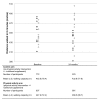Effect of a nutrition supplement and physical activity program on pneumonia and walking capacity in Chilean older people: a factorial cluster randomized trial
- PMID: 21526229
- PMCID: PMC3079648
- DOI: 10.1371/journal.pmed.1001023
Effect of a nutrition supplement and physical activity program on pneumonia and walking capacity in Chilean older people: a factorial cluster randomized trial
Abstract
Background: Ageing is associated with increased risk of poor health and functional decline. Uncertainties about the health-related benefits of nutrition and physical activity for older people have precluded their widespread implementation. We investigated the effectiveness and cost-effectiveness of a national nutritional supplementation program and/or a physical activity intervention among older people in Chile.
Methods and findings: We conducted a cluster randomized factorial trial among low to middle socioeconomic status adults aged 65-67.9 years living in Santiago, Chile. We randomized 28 clusters (health centers) into the study and recruited 2,799 individuals in 2005 (~100 per cluster). The interventions were a daily micronutrient-rich nutritional supplement, or two 1-hour physical activity classes per week, or both interventions, or neither, for 24 months. The primary outcomes, assessed blind to allocation, were incidence of pneumonia over 24 months, and physical function assessed by walking capacity 24 months after enrollment. Adherence was good for the nutritional supplement (~75%), and moderate for the physical activity intervention (~43%). Over 24 months the incidence rate of pneumonia did not differ between intervention and control clusters (32.5 versus 32.6 per 1,000 person years respectively; risk ratio = 1.00; 95% confidence interval 0.61-1.63; p = 0.99). In intention-to-treat analysis, after 24 months there was a significant difference in walking capacity between the intervention and control clusters (mean difference 33.8 meters; 95% confidence interval 13.9-53.8; p = 0.001). The overall cost of the physical activity intervention over 24 months was US$164/participant; equivalent to US$4.84/extra meter walked. The number of falls and fractures was balanced across physical activity intervention arms and no serious adverse events were reported for either intervention.
Conclusions: Chile's nutritional supplementation program for older people is not effective in reducing the incidence of pneumonia. This trial suggests that the provision of locally accessible physical activity classes in a transition economy population can be a cost-effective means of enhancing physical function in later life.
Trial registration: Current Controlled Trials ISRCTN 48153354.
Conflict of interest statement
Ricardo Uauy has declared: (1) I have a joint academic position between LSHTM and INTA U of Chile, the second position includes as part of my duties providing advice to the Chilean Ministry of Health on nutrition-related issues. (2) As President of the International Union of Nutritional Sciences IUNS 2005–09 I represented the IUNS providing advice on nutrition and food-related issues to the WHO, the FAO, and other UN agencies on topics related to the paper submitted to PLoS. (3) As President of the International Union of Nutritional Sciences IUNS 2005–09 I represented the IUNS in public/private partnerships; this included providing advice to industry on nutrition-related matters. No private gain was derived from these activities. IUNS policy is that these funds would be used to foster capacity in developing countries and would be disbursed by the incoming IUNS officers after I had completed my term as President. (4) I give presentations to scientific meetings that are supported by private foundations, or private sector industry and have had my travel paid by sponsors of these meetings, in topics related to nutrition and food. All other authors have declared that no competing interests exist.
Figures



References
-
- United Nations. World population prospects, the 2000 revision: highlights. New York: United Nations; 2001.
-
- World Health Organization. Nutrition for health and development – a global agenda for combating malnutrition. Progress report WHO/NHD/00.6. Geneva: World Health Organization; 2000.
-
- WHO. Active ageing: a policy framework. Geneva: World Health Organization; 2002.
-
- Knoops KT, de Groot LC, Kromhout D, Perrin AE, Moreiras-Varela O, et al. Mediterranean diet, lifestyle factors, and 10-year mortality in elderly European men and women: the HALE project. JAMA. 2004;292:1433–1439. - PubMed
-
- Manini TM, Everhart JE, Patel KV, Schoeller DA, Colbert LH, et al. Daily activity energy expenditure and mortality among older adults. JAMA. 2006;296:171–179. - PubMed
Publication types
MeSH terms
Associated data
Grants and funding
LinkOut - more resources
Full Text Sources
Medical

